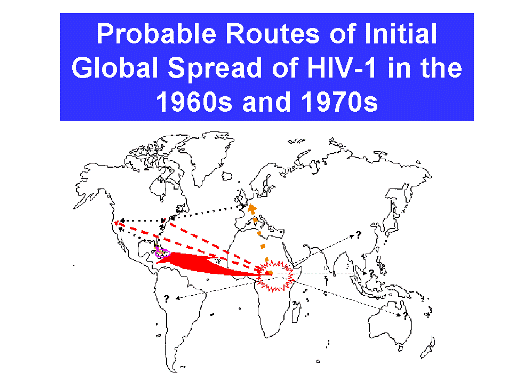| front |1 |2 |3 |4 |5 |6 |7 |8 |9 |10 |11 |12 |13 |14 |15 |16 |17 |18 |19 |20 |21 |22 |23 |24 |25 |26 |27 |28 |29 |30 |31 |32 |33 |review |
 |
The
origin of the human immunodeficiency virus (HIV) remains a sensitive
issue. The African origin of Simian Immunodeficiency Virus (SIV) is
not disputed. Also, not disputed is that SIV is the ancestral virus
of the Human Immunodeficiency Virus (HIV). HIV probably "jumped"
from simian hosts to humans many decades or Centuries ago somewhere
in Central Africa. During the 1970s, an increasing number of HIV
infected persons began to travel out of Africa.
Thousands of Haitians who were contract workers in Zaire (now
the Democratic Republic of the Congo) during the 1960s and 1970s
began returning during the early 1970s to Haiti and some probably
returned infected with HIV.
In addition,
there were during the 1970s reports of medical missionaries and some
Africans in several European countries who sought treatment for what may
have been AIDS. Increasingly during
the 1960s and 1970s,"sparks" of HIV infected persons traveled out of Africa
to Europe and North America and perhaps to most other global regions. These
"sparks" did not result in any epidemic spread and were thus, self limited
and remained silent and unrecognized.
When such sparks were introduced to gay bathhouses and/or IDU shooting
galleries during the 1970s, explosive HIV epidemics ensued.
HIV introduction and subsequent transmission probably occurred in
Haiti, North America and Western Europe, by the early to mid-1970s.
The Haitian
HIV/AIDS connection to Africa is not widely known.
All who may be interested in this connection should access the oral
history of AIDS website where NIH and CDC researchers recalled "in their own
words” the early investigations of AIDS -
http://aidshistory.nih.gov/home.htm |